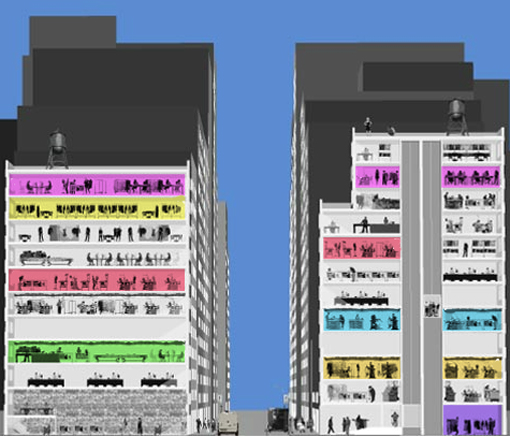Walking Broadway
Posted on November 16, 2011 | posted by:
‘Walking Broadway, 2009’ on YouTube
In summer 2009, I traveled down all of Broadway from 220th Street to Battery Park in Lower Manhattan. It was kind of a personal farewell ceremony since I planned to leave New York City a week later. I chose to walk. I knew that it was the best way not just to inscribe the city in my memory and body, but also to inscribe myself in the city through my feet.

There are roughly 100,000 buildings in Manhattan. Each building’s facade does not always look beautiful. Of course, some architecture, including the Guggenheim Museum, Frank Lloyd Wright’s masterpiece, is an exception. If we see each building as a living creature, I would say that the majority of them, resembling matchboxes, are ugly. Each building has its own function and they work really hard independently. Many people work and live under the glassy surfaces. In the book Emergence, Steven Johnson gives examples of how ants, brains, cities, and software live connectively.
The movement from low-level rules to higher-level sophistication is what we call emergence… Such a system would define the most elemental form of complex behavior: a system with multiple agents dynamically interacting in multiple ways, following local rules and oblivious to any higher-level instructions. But it wouldn’t truly be considered emergent until those local interactions resulted in some kind of discernible macrobehavior. (p. 18-19) This sort of complexity lives up one level: it describes the system of the city itself, and not its experiential reception by the city dweller. The city is complex because it overwhelms, yes, but also because it has a coherent personality, a personality that self-organizes out of millions of individual decisions, a global order built out of local interactions. This is the “systematic” complexity…(p. 39)
Personally, New York City is another great example of emergence. All the people, streets, buildings, cars, and parks in the city live their independent lives differently. However, somehow they interweave with others and exploit a great synergy. The buildings may not be beautiful, but all together they draw a breathtaking skyline. It is impossible to design it, even though somebody designs each building. The result just comes out without intended purpose. Especially, Steven Johnson emphasizes the importance of street.
Neighbors learn from each other because they pass each other-and each other’s stores and dwellings-on the sidewalk. Sidewalks allow relatively high-bandwidth communication between total strangers, and they mix large numbers of individuals in random configurations. Without the sidewalks, cities would be like ants without a sense of smell, or a colony with too few worker ants. Sidewalks provide both the right kind and the right number of local interactions. They are the gap junctions of city life.(p. 94)
The key to emergence in the city of New York is the street. As I felt while walking down Broadway, streets combine people with people and lifeless objects. New York City is divided into 5 boroughs and each borough is divided into many neighborhoods. Every district has unique faces but streets link them. They are communicating through streets and they deliver a new energy all over the city. Especially, Broadway is the main artery of Manhattan. If you watch the video clip carefully, you could recognize that the skyline changes from Washington Heights to Lower Manhattan drastically. As transdisciplinary designers, I think that we could learn from the city. This is a perfect playground for us and that is why we are here.